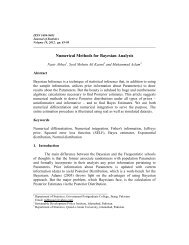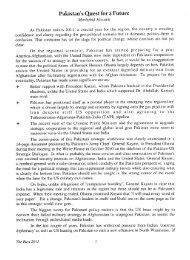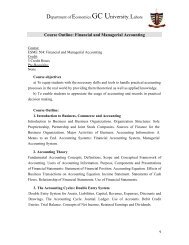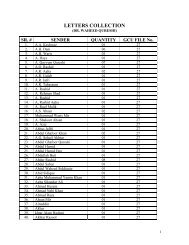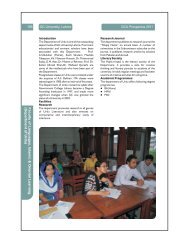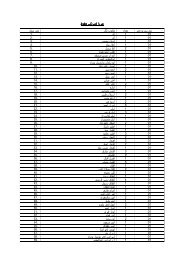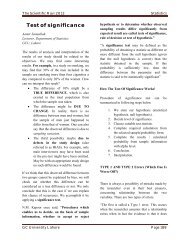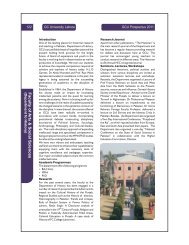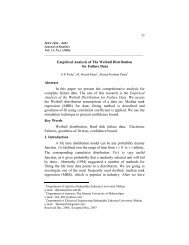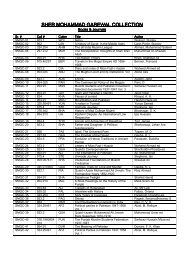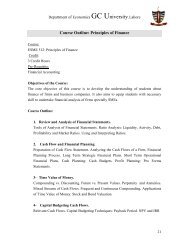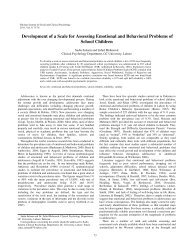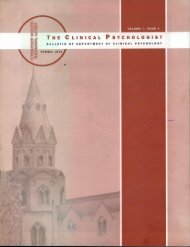Perception of Parental Acceptance and Rejection in Emotionally ...
Perception of Parental Acceptance and Rejection in Emotionally ...
Perception of Parental Acceptance and Rejection in Emotionally ...
Create successful ePaper yourself
Turn your PDF publications into a flip-book with our unique Google optimized e-Paper software.
Pakistan Journal <strong>of</strong> Social <strong>and</strong> Cl<strong>in</strong>ical Psychology<br />
2012, Vol. 9, No 3, 60-69<br />
<strong>Perception</strong> <strong>of</strong> <strong>Parental</strong> <strong>Acceptance</strong> <strong>and</strong> <strong>Rejection</strong> <strong>in</strong> <strong>Emotionally</strong><br />
Empathic <strong>and</strong> Non-Empathic Adolescents<br />
Saima Arzeen<br />
University <strong>of</strong> Peshawar, Peshawar<br />
Bushra Hassan<br />
University <strong>of</strong> Sussex, UK<br />
Muhammad Naveed Riaz<br />
University <strong>of</strong> Sargodha, Sargodha<br />
The present study explored the differences between emotionally empathic <strong>and</strong> non-empathic<br />
adolescent‘s perception <strong>of</strong> parental acceptance <strong>and</strong> rejection. A sample <strong>of</strong> 205 (100 girls <strong>and</strong> 105<br />
boys) was taken from different schools. All participants were 13 to 17 years old (M = 15.0, SD =<br />
1.59). All the participants were taken from private, government <strong>and</strong> semi government schools <strong>of</strong><br />
Wah Cantt. Two groups compris<strong>in</strong>g <strong>of</strong> 68 emotionally empathic <strong>and</strong> 68 non-empathic adolescents<br />
were identified on the basis <strong>of</strong> percentiles below 33 percentile <strong>and</strong> above 67th percentile <strong>of</strong> the total<br />
sample obta<strong>in</strong>ed on the Emotional Empathy Scale (EES). Emotional Empathy Scale (Ashraf, 2004)<br />
<strong>and</strong> <strong>Parental</strong> <strong>Acceptance</strong>–<strong>Rejection</strong> Questionnaire (Haque, 1981) was used to collect data from<br />
adolescents. The results <strong>in</strong>dicated that emotionally empathic adolescents significantly differed from<br />
non-empathic adolescents on all the dimension <strong>of</strong> PARQ. Also non-empathic adolescents perceived<br />
their fathers more neglect<strong>in</strong>g as compared to their mothers. The study has implication for the<br />
appropriate parent<strong>in</strong>g styles that predispose the adolescents‘ empathy level.<br />
Keywords: parental acceptance <strong>and</strong> rejection, emotional empathy, empathetic adolescents, nonempathetic<br />
adolescents<br />
The efforts to identify antecedents to the development <strong>of</strong><br />
emotional empathy have primarily focused on the family<br />
environment; the most pert<strong>in</strong>ent seem to be parent-child <strong>in</strong>teraction<br />
(Barnett, K<strong>in</strong>g, Howard, & D<strong>in</strong>o, 1980; Bryant, 1980; Eisenberg &<br />
Fabes, 1998; Eisenberg & Mussen, 1989; Eisenberg, 1992;<br />
Eisenberg, Fabes, Schaller, Carlo, & Miller, 1991; Feshbach, 1987;<br />
Grusec, 1981; Rob<strong>in</strong>son, Zahn-Waxler, & Emde, 1994; Kim &<br />
Rohner , 2003; Zahn-Waxler et al 1979). Emotional empathy refers<br />
to the tendency to feel <strong>and</strong> experience vicariously the (positive <strong>and</strong><br />
negative) emotional experiences <strong>and</strong> or expressions for othersfeel<strong>in</strong>gs<br />
(Mehrabian, 1996).<br />
<strong>Parental</strong> relationship with their children has frequently been<br />
conceptualized <strong>in</strong> terms <strong>of</strong> <strong>in</strong>teraction between two sets <strong>of</strong> parental<br />
attributes i.e., parental warmth / acceptance <strong>and</strong> rejection. These<br />
dimensions help us expla<strong>in</strong> the diverse ways <strong>in</strong> which parents can<br />
br<strong>in</strong>g up their children <strong>and</strong> how their behavior foster positive<br />
feel<strong>in</strong>gs <strong>in</strong> the child, thus promot<strong>in</strong>g normal social development.<br />
The empirical work on parental acceptance-rejection was <strong>in</strong>itiated<br />
<strong>in</strong> 1930 <strong>and</strong> now more than 2000 studies are available on this<br />
subject (Rohner, 2007). Majority <strong>of</strong> the research is done <strong>in</strong> the<br />
western world/cultures <strong>and</strong> not <strong>in</strong> South Asian contexts, it is<br />
significant that some research <strong>in</strong>terests should be pursued <strong>in</strong><br />
Pakistan to <strong>in</strong>vestigate whether the same patterns <strong>of</strong> parent–child<br />
<strong>in</strong>teraction <strong>in</strong> emotional empathy <strong>of</strong> adolescents exist or not. In the<br />
present study, keep<strong>in</strong>g <strong>in</strong> m<strong>in</strong>d the differences <strong>in</strong> the parental child<br />
<strong>in</strong>teractions <strong>and</strong> the ways <strong>in</strong> which parental acceptance <strong>and</strong><br />
Correspondence concern<strong>in</strong>g this article should be addressed to Bushra<br />
Hassan PhD Scholar, School <strong>of</strong> Psychology, University <strong>of</strong> Sussex, Falmer,<br />
Brighton, UK. Email: bushimalik@gmail.com<br />
rejection can be exercised, we assume that there would be some<br />
difference among the <strong>in</strong>teraction styles <strong>of</strong> emotionally empathic <strong>and</strong><br />
emotionally non-empathic adolescents <strong>in</strong> Pakistan.<br />
Role <strong>of</strong> Family <strong>in</strong> the Development <strong>of</strong> Emotional Empathy<br />
Barnett (1987) proposed that the development <strong>of</strong> empathy is<br />
most likely to occur <strong>in</strong> a family environment that (a) satisfies the<br />
child‘s own emotional needs <strong>and</strong> discourages excessive selfconcern,<br />
(b) encourages the child to experience <strong>and</strong> express a broad<br />
range <strong>of</strong> emotions, <strong>and</strong> (c) provides opportunities for the child to<br />
observe <strong>and</strong> <strong>in</strong>teract with others who encourage emotional<br />
sensitivity <strong>and</strong> responsiveness. One parental variable that seems to<br />
fit well <strong>in</strong>to Barnett‘s (1987) criterion for the socialization <strong>of</strong><br />
empathy is parental warmth. Similarly, Allport (1961) argued that<br />
the basis <strong>of</strong> empathic ability <strong>in</strong>cludes a secure home environment.<br />
Children, who come from the permissive family environment, are<br />
more tolerant <strong>and</strong> empathic than those children who come from the<br />
harsh, submissive families.<br />
Role <strong>of</strong> <strong>Parental</strong> Socialization <strong>in</strong> adolescent Empathic<br />
Respond<strong>in</strong>g<br />
Parents <strong>and</strong> general home environment have been considered<br />
very important factors which affect children‘s development<br />
<strong>in</strong>clud<strong>in</strong>g empathy <strong>and</strong> other relevant personality traits (McCrae &<br />
Costa, 1988). Eisenberg <strong>and</strong> Fabes (1998) <strong>in</strong>vestigated that<br />
children‘s observation about their parents <strong>and</strong> <strong>in</strong>teractions with<br />
parents are likely to contribute to <strong>in</strong>dividual differences <strong>in</strong> empathy<br />
related respond<strong>in</strong>g. In addition, H<strong>of</strong>fman (1982 & 2000) argued<br />
that expos<strong>in</strong>g children to models who act altruistically <strong>and</strong> who<br />
express their sympathetic feel<strong>in</strong>gs contributes to children‘s act<strong>in</strong>g
ARZEEN, HASSAN, AND RIAZ 61<br />
empathetically rather than mak<strong>in</strong>g counter empathetic attributions<br />
about the causes <strong>of</strong> people‘s distress. However, there are some<br />
researches that also suggest a relationship between poor parent<strong>in</strong>g<br />
(neglect / rejection) with low levels <strong>of</strong> empathy, M<strong>in</strong>or, Karr <strong>and</strong><br />
Ja<strong>in</strong>, (1987) found that lack <strong>of</strong> empathy is positively related to<br />
abusive parental behavior. Moreover, it is also evident from the<br />
literature, that socialite‘s use <strong>of</strong> power–assertive techniques <strong>of</strong><br />
discipl<strong>in</strong>e ( physical punishment, deprivation <strong>of</strong> privileges, threats<br />
<strong>of</strong> either <strong>of</strong> these) has been found to be either unrelated (Mussen,<br />
Rutherford, Harris, & Keasey, 1970; Olejnik & McK<strong>in</strong>ney, 1973;<br />
Zahn-Waxler et al., 1979) or negatively related with children‘s prosocial<br />
development (Bar–Tal, Nadler & Blechman,1980;<br />
Dlugowski & Firestone, 1974; Eisenberg, 1995; Hast<strong>in</strong>gs, Zahn-<br />
Waxler, Rob<strong>in</strong>son, Usher, & Bridges, 2000; H<strong>of</strong>fman, 1963;<br />
Supple, 2001), <strong>and</strong> levels <strong>of</strong> empathy <strong>in</strong> young adults (Brems &<br />
Sohl,1995; Eisikovits & Sagi, 1982; Miller & Eisenberg, 1988;<br />
Rich, 1983; Supple, 2001). Thus one might conclude that early<br />
parent<strong>in</strong>g practices <strong>and</strong> experiences are <strong>of</strong> primary importance <strong>in</strong><br />
the development <strong>of</strong> empathic concern <strong>and</strong> dispositions <strong>in</strong> children.<br />
Schaffer (as cited <strong>in</strong> Hamner & Turner, 1990), exam<strong>in</strong>ed the<br />
concepts <strong>of</strong> mother<strong>in</strong>g from four pr<strong>in</strong>cipal perspectives: mother<strong>in</strong>g<br />
as physical care, mother<strong>in</strong>g as a set <strong>of</strong> attitudes, mother<strong>in</strong>g as<br />
stimulation, <strong>and</strong> mother<strong>in</strong>g as mutual dialogues. There are certa<strong>in</strong><br />
environmental conditions that a mother can provide to enhance the<br />
development <strong>and</strong> competence <strong>of</strong> their children. It is an essential<br />
part for human <strong>in</strong>fant to become attached to a mother figure,<br />
because strong mother-child attachment is a major antecedent <strong>of</strong><br />
early <strong>in</strong>terest <strong>in</strong> others <strong>and</strong> can be a necessary precondition for the<br />
child development (A<strong>in</strong>sworth, 1979; Mussen & Eisenberg-Berg,<br />
1977). Moreover, P<strong>in</strong>es <strong>and</strong> Marron (2003) also suggested that the<br />
quality <strong>of</strong> mother-child attachment plays a central role <strong>in</strong> the<br />
development <strong>of</strong> pro-social behavior <strong>in</strong> general <strong>and</strong> <strong>in</strong> promot<strong>in</strong>g<br />
empathic concern <strong>in</strong> particular (also see, Nathanson, 1996).<br />
Kestenbaum, Farber <strong>and</strong> Sroufe (1989) also found that children<br />
who have a warm, lov<strong>in</strong>g relationship with their caregivers<br />
especially mothers, feel secure <strong>and</strong> that security makes them to<br />
th<strong>in</strong>k about others rather than focus<strong>in</strong>g entirely on themselves.<br />
Several researches have found that mothers <strong>of</strong> pre-school children<br />
who are responsive, non-punitive <strong>and</strong> non-authoritarian their<br />
children exhibit higher sense <strong>of</strong> affective <strong>and</strong> cognitive empathy<br />
<strong>and</strong> pro social behavior.( Cotton, 2001; Dekovic & Janssens, 1992;<br />
Eisenberg–Berg & Mussen,1978; Eisenberg, Fabes, & Murphy,<br />
1996; Eisenberg, Fabes, Carlo, Troyer, Speer, Karbon, Switzer,<br />
1992; Eisenberg, Fabes, Schaller, Carlo, & Miller, 1991;<br />
Eisenberg, Lennon, & Roth, 1983; Kestenbaum, Farber, & Sroufe,<br />
1989; Krevans & Gibbs, 1996; Zahn-Waxier, Radke-Yarrow, &<br />
K<strong>in</strong>g, 1979). However, Rob<strong>in</strong>son, Zahn-Waxler, <strong>and</strong> Emde,<br />
(1994) found that maternal warmth predicted high levels <strong>of</strong><br />
empathic respond<strong>in</strong>g <strong>in</strong> 14 to 20 months <strong>in</strong>fants, <strong>and</strong> maternal<br />
negative control predicted decreases <strong>in</strong> empathic respond<strong>in</strong>g over<br />
this period.<br />
The term ―father<strong>in</strong>g‖ appears <strong>in</strong> context <strong>of</strong> the more direct<br />
psychological <strong>and</strong> physical role a man enacts <strong>in</strong> the rear<strong>in</strong>g <strong>of</strong> his<br />
children (cited <strong>in</strong> Hanson & Bozetti, 1985). Fathers may have<br />
greater impact on the maladjustment <strong>in</strong> their children rather than <strong>in</strong><br />
the development <strong>of</strong> positive behavior (Gottman, Katz, & Hooven,<br />
1996; Koestner, Franz, & We<strong>in</strong>berger, 1990; Reeves, Werey,<br />
Elk<strong>in</strong>d, & Zanatk<strong>in</strong>, 1987; Tallmadge & Barkley, 1983). However,<br />
there are some recent researches which show that fathers also play<br />
a very important role <strong>in</strong> the development <strong>of</strong> positive behavior<br />
(especially empathic concern) <strong>in</strong> their children. For example, Biller<br />
<strong>and</strong> Trotter (1994) found that primary school children, who scored<br />
higher on the test <strong>of</strong> empathy, had secure attachment to their father<br />
dur<strong>in</strong>g <strong>in</strong>fancy (Biller, 1982; Biller, 1993; Reuter & Biller; 1973).<br />
Similarly, H<strong>in</strong>chey <strong>and</strong> Gavelek (1982) found that children <strong>of</strong> nonabusive<br />
fathers exhibited greater empathy as compared to children<br />
<strong>of</strong> abusive fathers. Literature shows that both father <strong>and</strong> mother<br />
play an important role <strong>in</strong> foster<strong>in</strong>g empathic feel<strong>in</strong>gs <strong>and</strong> concerns<br />
<strong>in</strong> children.<br />
Child-Rear<strong>in</strong>g Styles: <strong>Parental</strong> Warmth-<strong>Rejection</strong><br />
In order to underst<strong>and</strong> the processes through which parents<br />
<strong>in</strong>fluence child development, one must underst<strong>and</strong> the parent<strong>in</strong>g<br />
style, or emotional climate with<strong>in</strong> which socialization occurs. As a<br />
result <strong>of</strong> researches conducted <strong>in</strong> the field <strong>of</strong> child development<br />
two ma<strong>in</strong> doma<strong>in</strong>s <strong>of</strong> child rear<strong>in</strong>g styles have been identified<br />
(Bronste<strong>in</strong>, 1994; Hether<strong>in</strong>gton & Parke, 1986; Schaeffer, 1959).<br />
<strong>Parental</strong> warmth, the first dimension is conceptualized <strong>in</strong> term <strong>of</strong><br />
concepts such as attachment, acceptance, hostility, <strong>and</strong> rejection.<br />
<strong>Parental</strong> control, the second dimension is conceptualized <strong>in</strong> such<br />
term as monitor<strong>in</strong>g, supervision, control, <strong>and</strong> discipl<strong>in</strong>e. In a great<br />
majority <strong>of</strong> factor analytical studies (as cited <strong>in</strong> Rohner, &<br />
Pettengill, 1985) completed on children‘s perceptions <strong>of</strong> parental<br />
behavior <strong>in</strong>ternationally, the warmth dimension emerged first, with<br />
control dimension <strong>of</strong>ten emerg<strong>in</strong>g second. It was also found that<br />
these two dimensions <strong>of</strong> parent<strong>in</strong>g are <strong>in</strong>dependent <strong>of</strong> each other.<br />
However, several researchers suggested the importance <strong>of</strong> warmth<br />
dimension <strong>in</strong> the development <strong>of</strong> positive developmental outcomes<br />
(Kestenbaum, Farber, & Sroufe, 1989; Rohner, 2001).<br />
<strong>Parental</strong> warmth refers to the amount <strong>of</strong> affection <strong>and</strong> approval<br />
that an adult displays toward his or her child. Parents described as<br />
warm <strong>and</strong> nurtur<strong>in</strong>g are those, who <strong>of</strong>ten smile at, praise <strong>and</strong><br />
encourage their child while limit<strong>in</strong>g their criticism, punishments<br />
<strong>and</strong> sign <strong>of</strong> disapproval. Warm parents are deeply committed to the<br />
child‘s welfare, <strong>and</strong> are responsive to the child‘s need. They are<br />
will<strong>in</strong>g to spend time <strong>in</strong> jo<strong>in</strong>t enterprises <strong>of</strong> the child‘s choos<strong>in</strong>g.<br />
Parents who are rated high on warmth show higher level <strong>of</strong><br />
concern, <strong>in</strong>volvement <strong>and</strong> affection toward their children. Warmth<br />
may be expressed behaviorally by the parent ma<strong>in</strong>ly <strong>in</strong> terms <strong>of</strong><br />
higher levels <strong>of</strong> typical warm behavior e.g., show<strong>in</strong>g more active<br />
concern, caretak<strong>in</strong>g <strong>and</strong> playful jok<strong>in</strong>g behavior. All k<strong>in</strong>ds <strong>of</strong><br />
nurtur<strong>in</strong>g, supportive <strong>and</strong> lov<strong>in</strong>g, behaviors are expressions <strong>of</strong><br />
parental acceptance. In contrast, reject<strong>in</strong>g parents criticize, punish<br />
or ignore a child‘s physical <strong>and</strong> emotional needs while limit<strong>in</strong>g<br />
their expression <strong>of</strong> affection <strong>and</strong> approval. Such parents dislike,<br />
disapprove <strong>of</strong>, or recent their children openly through their<br />
behavior usually called aggression. Reject<strong>in</strong>g parents experience<br />
their aggression physically by hitt<strong>in</strong>g, push<strong>in</strong>g, p<strong>in</strong>ch<strong>in</strong>g <strong>and</strong><br />
hurt<strong>in</strong>g the child whereas verbal expression <strong>of</strong> anger <strong>in</strong>volves<br />
sarcastic, curs<strong>in</strong>g, shout<strong>in</strong>g, humiliat<strong>in</strong>g, <strong>and</strong> behavior toward the<br />
child. All forms <strong>of</strong> these behaviors tend to <strong>in</strong>clude children to feel<br />
unloved or rejected (Haque, 1987; Sheikh & Haque, 1994).<br />
Support for the association <strong>of</strong> parental warmth/responsivity with<br />
children‘s empathy can be gleaned from research <strong>and</strong> theory <strong>in</strong> a<br />
number <strong>of</strong> related areas: Theoretical perspectives shows that<br />
children rear<strong>in</strong>g correlates with pro-social <strong>and</strong> moral development;<br />
<strong>Parental</strong> warmth/responsivity is hypothesized to promote children‘s<br />
empathy <strong>and</strong> pro-social behavior because it gives children feel<strong>in</strong>gs<br />
<strong>of</strong> security, control, <strong>and</strong> trust <strong>in</strong> the environment, which would<br />
m<strong>in</strong>imize self–concern <strong>and</strong> leave room to consider <strong>and</strong> respond to<br />
others‘ feel<strong>in</strong>gs (H<strong>of</strong>fman, 1982; Janssen & Gerris, 1992; Radke-
PARENTAL ACCEPTANCE REJECTION AND EMOTIONAL EMPATHY 62<br />
Yarrow, Zahn-waxler, & Chapman, 1983; Staub, 1979) . Secondly,<br />
<strong>in</strong> the attachment literature, parental warmth /responsively is<br />
viewed as a critical component for the development <strong>of</strong> a secure<br />
attachment between the caregiver <strong>and</strong> <strong>in</strong>fant (A<strong>in</strong>worth, Blehar,<br />
Waters, & Wall, 1978), <strong>and</strong> a secure attachment predicts children‘s<br />
concurrent (current level <strong>of</strong> emotional empathy <strong>in</strong> childhood) <strong>and</strong><br />
latter empathy (the tendencies to be empathetic <strong>in</strong> adolescence <strong>and</strong><br />
adult stages related respond<strong>in</strong>g. <strong>Parental</strong> <strong>Acceptance</strong>-<strong>Rejection</strong><br />
Theory by Rohner (1975) also expla<strong>in</strong>s the association <strong>of</strong> parental<br />
warmth / responsivity with emotional empathy among adolescents.<br />
<strong>Parental</strong> <strong>Acceptance</strong>- <strong>Rejection</strong> Theory (PAR Theory)<br />
Rohner (2007) <strong>in</strong>troduced <strong>Parental</strong>-<strong>Acceptance</strong>-<strong>Rejection</strong><br />
Theory (PAR), accord<strong>in</strong>g to Rohner, parental warmth is bipolar<br />
dimension where acceptance st<strong>and</strong>s at one pole <strong>of</strong> the scale <strong>and</strong><br />
rejection (absence <strong>of</strong> acceptance <strong>and</strong> warmth) falls on the other<br />
pole. Rohner (2007) has def<strong>in</strong>ed the acceptance <strong>and</strong> rejection <strong>in</strong><br />
terms <strong>of</strong> the child‘s perception <strong>of</strong> parental behavior. PAR Theory<br />
postulates that humans everywhere have a fundamental,<br />
phylogenetically acquired need for positive response (i.e., love<br />
approval, warmth <strong>and</strong> affection) from people most important to<br />
them—i.e., from parents <strong>and</strong> other attachment figures (Rohner,<br />
Khaleque, & Cournoyer, 2010). This need for positive response is<br />
basic for the normal development <strong>and</strong> the withdrawal <strong>of</strong> affection<br />
is sufficient by itself to produce negative consequences for<br />
emotional <strong>and</strong> personality traits <strong>and</strong> behavioral function<strong>in</strong>g.<br />
Depend<strong>in</strong>g on the extent to which the need is satisfied, humans are<br />
expected <strong>in</strong> the theory to develop a specific cluster <strong>of</strong> dispositions,<br />
<strong>in</strong>clud<strong>in</strong>g hostility, aggression, passive aggression, problems with<br />
the management <strong>of</strong> hostility <strong>and</strong> aggression; dependence, healthy<br />
<strong>in</strong>dependence, or defensive <strong>in</strong>dependence; positive or negative selfesteem;<br />
positive or negative self-adequacy; emotional<br />
(un)responsiveness; emotional (<strong>in</strong>) stability; <strong>and</strong> positive or<br />
negative worldviews. This theory also predicts that the rejected<br />
children tend more than accepted children to be hostile, aggressive,<br />
to be dependent, <strong>and</strong> to have an impaired sense <strong>of</strong> self-esteem <strong>and</strong><br />
self–adequacy, to be emotionally unstable; to be emotionally<br />
unresponsive, <strong>and</strong> to have a world negative view. Thus, accord<strong>in</strong>g<br />
to this theory, whether a parent accepts or rejects the child, it<br />
significantly affects the child‘s personality formation <strong>and</strong><br />
development. <strong>Parental</strong> acceptance–rejection theory is a theory <strong>of</strong><br />
socialization which attempts to expla<strong>in</strong> <strong>and</strong> predict major<br />
consequences <strong>of</strong> rejection for behavioral, cognitive, <strong>and</strong> emotional<br />
development <strong>of</strong> children <strong>and</strong> for personality function<strong>in</strong>g <strong>of</strong> adult<br />
everywhere. The researches <strong>and</strong> cl<strong>in</strong>ical reports support the<br />
expectations that have been implicated <strong>in</strong> the wide range <strong>of</strong><br />
psychiatric <strong>and</strong> behavioral disorders. The postulates <strong>of</strong> the theory<br />
are supported by converg<strong>in</strong>g evidence from holocultural studies<br />
<strong>and</strong> numerous psychological studies conducted <strong>in</strong> the west as well<br />
as <strong>in</strong> Pakistan (Kausar & Tabassum, 1990; Khaleque & Rohner,<br />
2002a; Mussen, Conger, Kagan, & Hustor, 1984; Riaz, 2005;<br />
Rohner, 2006).<br />
A good deal <strong>of</strong> research is evident that the underly<strong>in</strong>g<br />
assumptions <strong>of</strong> PAR Theory effects mental health related outcomes<br />
(Chyung & Lee, 2006; Khaleque, Laukala, & Rohner 2006; Ruan &<br />
Rohner, 2004; Varan, Rohner, & Eryuksel, 2006). Thus, strong<br />
evidence supports, PAR Theory‘s expectations that children<br />
everywhere who come from lov<strong>in</strong>g (accept<strong>in</strong>g) families are more<br />
likely than children who come from unlov<strong>in</strong>g (reject<strong>in</strong>g) families to<br />
feel good about themselves (positive self-esteem); feel competent<br />
(positive self-adequacy); have the capacity to freely <strong>and</strong> nondefensively<br />
develop <strong>in</strong>timate, trust<strong>in</strong>g relationships (emotional<br />
responsiveness); view the world <strong>and</strong> most humans as be<strong>in</strong>g<br />
benevolent or positive <strong>in</strong> other ways (Babree, 1997; Barnett, 1987;<br />
Davis, 1983; H<strong>of</strong>fman, 1963; Kim & Rohner, 2003; Rohner, 2004).<br />
Despite the importance <strong>of</strong> the empathy <strong>in</strong> social development,<br />
research concern<strong>in</strong>g parental role <strong>in</strong> the development <strong>of</strong> empathy<br />
has been sparse. In Pakistan, it has been almost nonexistent.<br />
Therefore, based on <strong>Parental</strong> <strong>Acceptance</strong> <strong>and</strong> <strong>Rejection</strong> (PAR)<br />
theory proposed <strong>and</strong> developed by Rohner (1975), the present study<br />
aimed at explor<strong>in</strong>g how the adolescent perception <strong>of</strong> parental<br />
acceptance <strong>and</strong> rejection could be related to their level <strong>of</strong> emotional<br />
empathy <strong>in</strong> the <strong>in</strong>digenous context. PAR theory hav<strong>in</strong>g expla<strong>in</strong>ed<br />
well the socialization that attempts to predict <strong>and</strong> expla<strong>in</strong> major<br />
antecedents, consequences, <strong>and</strong> other correlates <strong>of</strong> parental<br />
acceptance <strong>and</strong> rejection with<strong>in</strong> the United States <strong>and</strong> worldwide<br />
(Rohner, 1975, 1986, 1994, 1999), test<strong>in</strong>g it <strong>in</strong> the cultural context<br />
<strong>of</strong> Pakistan has theoretical <strong>and</strong> practical significance.<br />
An ample <strong>of</strong> research provides an evidence that parents<br />
acceptance rejection effects mental health related outcomes.<br />
(Ahmed, Gielen, & Al-Sabah, 2008; Erkman, Caner, Sart, Borkan,<br />
& Sahan, 2010; Kourkoutas, & Tsiampoura, 2011; Kourkoutas, &<br />
Erkman, 2011; Rohner, 2010). <strong>Parental</strong> acceptance is positively<br />
associated with ego-strength (Ahmed, Al-Otaibi, & Gielen, 2008),<br />
social development (Gulay, 2011), sibl<strong>in</strong>g relationship quality<br />
(Kanyas, 2008), <strong>and</strong> emotional <strong>in</strong>telligence (Alegre & Benson,<br />
2008) whereas it is negatively associated with depression <strong>and</strong><br />
related symptoms (Gulay, 2011; Majeed, 2009; Salahur, 2010).<br />
<strong>Parental</strong> acceptance ensures healthy social <strong>and</strong> emotional<br />
adjustment (Akkus, 2010; Alegre, & Benson, 2008; Chyung & Lee,<br />
2008; Demetriou & Christodoulides, 2011; Dwairy, 2010; Khaleque<br />
& Rohner, 2011; Khaleque, Rohner, & Rahman, 2011; Rohner,<br />
Varan, & Koberste<strong>in</strong>, 2010).<br />
The present study was based on cross-sectional survey research<br />
design. The present study‘s ma<strong>in</strong> objective has been tw<strong>of</strong>old: One<br />
to study whether the adolescent emotional empathy is associated<br />
with child rear<strong>in</strong>g practices <strong>and</strong> secondly, to <strong>in</strong>vestigate the patterns<br />
<strong>of</strong> parent–child <strong>in</strong>teractions as perceived by the identified<br />
emotionally empathic <strong>and</strong> non-empathic adolescents. On the basis<br />
<strong>of</strong> the literature review, follow<strong>in</strong>g hypotheses are formulated:<br />
H 1 : Perceived parental warmth will be higher among emotionally<br />
empathic adolescents as compared to non-empathic adolescents.<br />
H 2 : Perceived parental aggression will be lower among emotionally<br />
empathic adolescents as compared to non-empathic adolescents.<br />
H 3 : Perceived undifferentiated parental rejection will be lower<br />
among emotionally empathic adolescents as compared to nonempathic<br />
adolescents.<br />
H 4 : Perceived parental neglect will be lower among emotionally<br />
empathic adolescents as compared to non-empathic adolescents.<br />
H5: <strong>Emotionally</strong> empathic students will perceive their mothers<br />
more warmth than their fathers.<br />
H6: Non empathic student‘s parents will be more reject<strong>in</strong>g than<br />
emotionally empathic students‘ parents.<br />
Participants<br />
Method<br />
The sample <strong>of</strong> the study comprised <strong>of</strong> 205 students (105 boys,<br />
100 girls) <strong>of</strong> 9 th <strong>and</strong> 10 th grade. The age range <strong>of</strong> these adolescents<br />
was 13-17 years (M = 15.0, SD = 1.59). The sample <strong>in</strong>cluded 105
ARZEEN, HASSAN, AND RIAZ 63<br />
boys <strong>and</strong> 100 girls. Among 105 boys who participated <strong>in</strong> the study,<br />
55 boys were selected from 9th grade <strong>and</strong> 50 boys were selected<br />
from 10 th grade. Similarly, among 100 girls, 50 girls were selected<br />
from 9 th grade <strong>and</strong> 50 girls were selected from 10 th grade.<br />
Measures<br />
Emotional Empathy Scale: The scale developed by Ashraf<br />
(2004) has been used <strong>in</strong> the present research to identify emotionally<br />
empathic <strong>and</strong> non–empathic adolescents. The scale consists <strong>of</strong> 26<br />
items <strong>and</strong> is a self-report measure <strong>of</strong> the tendency to experience<br />
vicariously the (positive <strong>and</strong> negative) emotional experiences <strong>of</strong><br />
others. The scale is based on 7-po<strong>in</strong>t Likert-type response format.<br />
The response categories range from 1 for ―absolutely disagree‖ to 7<br />
for ―absolutely agree‖. The total scores on the scale range from 26<br />
as m<strong>in</strong>imum <strong>and</strong> 182 for maximum scores on the overall scale. The<br />
scale is <strong>in</strong>tended for the use with adolescents <strong>and</strong> general adult<br />
population. The norm for the scale have been developed (M = 143,<br />
SD = 20). Two groups compris<strong>in</strong>g <strong>of</strong> emotionally empathic <strong>and</strong><br />
non-empathic adolescents were identified on the basis <strong>of</strong> percentiles<br />
(33 percentile upper <strong>and</strong> 33 percentile lower cases) <strong>of</strong> the total<br />
sample obta<strong>in</strong>ed on the Emotional Empathy Scale. The <strong>in</strong>ternal<br />
reliabilities (alpha coefficient) <strong>of</strong> the scale was .85 where as its item<br />
total correlation at p < .000 ranged from .31 to .60. The split half<br />
reliability <strong>of</strong> the scale was .83. The alpha coefficient <strong>of</strong> the scale <strong>in</strong><br />
present study was 0.81, which is also quite satisfactory. Multiple<br />
types <strong>of</strong> validity evidences were reported by the author <strong>in</strong>clud<strong>in</strong>g<br />
factorial validity, convergent validity, <strong>and</strong> discrim<strong>in</strong>ant validity <strong>of</strong><br />
the scale. The sample items <strong>in</strong>clude ―see<strong>in</strong>g people deceiv<strong>in</strong>g others<br />
causes great trouble for me‖ <strong>and</strong> ―when I come across a<br />
h<strong>and</strong>icapped, I feel sad‖.<br />
<strong>Parental</strong> <strong>Acceptance</strong>-<strong>Rejection</strong> Questionnaire: For<br />
<strong>in</strong>vestigat<strong>in</strong>g the Child parent Interaction <strong>of</strong> the participants, the<br />
<strong>Parental</strong> <strong>Acceptance</strong>-<strong>Rejection</strong> Questionnaire (PARQ) developed<br />
by Rohner, Saaverda, <strong>and</strong> Granum (1980) was used <strong>in</strong> the present<br />
study. The orig<strong>in</strong>al PARQ is <strong>in</strong> English language however for the<br />
present study Urdu version <strong>of</strong> PARQ translated by Haque (1981)<br />
was used. An analysis <strong>of</strong> reliability <strong>of</strong> translated PARQ showed that<br />
the translated <strong>in</strong>strument is psychometrically adequate (Haque,<br />
1981, 1987). Additional evidence detailed <strong>in</strong> Rohner (1975) shows<br />
the convergent, discrim<strong>in</strong>ation <strong>and</strong> construct validities <strong>of</strong> PARQ to<br />
be satisfactory. PARQ has been used <strong>in</strong> Pakistan <strong>in</strong> various studies<br />
(Haque, 1981, 1987; Karim 1986; Riaz, 2005; Shah, Malik, &<br />
Jaffari, 1994; Sheikh & Haque, 1994) <strong>and</strong> reported to be construct<br />
valid <strong>in</strong>strument. In presents study alpha coefficient <strong>of</strong> the<br />
<strong>in</strong>dividual scales ranged from .71 to .89 <strong>and</strong> for the total scale was<br />
found to be .94 which is also quite satisfactory.<br />
This questionnaire consists <strong>of</strong> two parts each compris<strong>in</strong>g <strong>of</strong> 60<br />
items. Part-I measures attitude <strong>of</strong> father towards the child whereas<br />
the Part-II measures attitudes <strong>of</strong> mothers towards the child at the<br />
age <strong>of</strong> 7-11 year olds. Each part yields four separate scores i.e.,<br />
<strong>Parental</strong> <strong>Acceptance</strong>/Warmth; refers to the amount <strong>of</strong> affection that<br />
parents display towards their children (20 items). <strong>Parental</strong><br />
aggression; the conditions where parents are perceived to be angry,<br />
bitter, resentful, <strong>in</strong>tended to hurt, physically or verbally (15 items),<br />
<strong>Parental</strong> Neglect; the conditions where <strong>in</strong>dividuals see their parents<br />
as unconcerned or un<strong>in</strong>terested (15 items) <strong>and</strong> Undifferentiated<br />
parental <strong>Rejection</strong>; the conditions where <strong>in</strong>dividuals perceive their<br />
parents reject<strong>in</strong>g, but where the expression <strong>of</strong> rejection is not clearly<br />
unaffectionate, aggressive or neglect<strong>in</strong>g (10 items). There is no cut<br />
<strong>of</strong>f scores <strong>in</strong> these subscales. Therefore high sores <strong>in</strong>dicate high<br />
acceptance or rejection <strong>and</strong> vice versa. The sample items <strong>of</strong> paternal<br />
acceptance <strong>and</strong> rejection <strong>in</strong>clude ―my father likes to spend time with<br />
me‖ <strong>and</strong> ―my father <strong>in</strong> fact does not love me‖ respectively. The<br />
sample items for maternal acceptance <strong>and</strong> rejection <strong>in</strong>clude ―my<br />
mother tries to keep me happy‖ <strong>and</strong> ―my mother beats me without<br />
any reason‖ respectively. This questionnaire is five- po<strong>in</strong>t rat<strong>in</strong>g<br />
scale ranges from strongly agree to strongly disagree (1-5) . Both<br />
scale were obta<strong>in</strong>ed from Test<strong>in</strong>g Resource Centre <strong>of</strong> National<br />
Institute <strong>of</strong> Psychology <strong>and</strong> were used with the permission <strong>of</strong> the<br />
center.<br />
Procedure<br />
A group <strong>of</strong> emotionally empathic adolescents (n = 68) was<br />
identified from the adolescents who fall above the 67 th percentile <strong>of</strong><br />
the total sample (n = 205) on Emotional Empathy Scale. After<br />
identify<strong>in</strong>g the emotionally empathic adolescents, a group <strong>of</strong> nonempathic<br />
adolescents (n = 68) was also identified from the<br />
adolescents who fall below 33 rd percentile <strong>of</strong> the total sample on<br />
Emotional Empathy Scale. While the rest <strong>of</strong> students whose score<br />
between the 33 percentiles to 67 percentile were excluded from the<br />
ma<strong>in</strong> analysis for hypothesis test<strong>in</strong>g. The purposive convenient<br />
sampl<strong>in</strong>g was used <strong>in</strong> data collection after gett<strong>in</strong>g the permission<br />
from the school authority<br />
Results<br />
A significant difference is found among the perception <strong>of</strong><br />
emotionally empathic as compared to non- empathic adolescents on<br />
the dimension <strong>of</strong> Paternal <strong>and</strong> Maternal Warmth on PARQ.<br />
<strong>Emotionally</strong> empathic adolescents have found to perceive their<br />
fathers <strong>and</strong> mothers warmer as compared to non-empathic<br />
adolescents. <strong>Emotionally</strong> empathic adolescents have perceived their<br />
fathers <strong>and</strong> mothers less aggressive as compared to non-empathic<br />
adolescents. The results for fathers <strong>and</strong> for mothers support our<br />
second hypothesis that perceived paternal /maternal aggression will<br />
be low among emotionally empathic adolescents as compared to<br />
non-empathic adolescents. It has been found that emotionally<br />
empathic adolescents have perceived their fathers <strong>and</strong> mothers as<br />
less neglect<strong>in</strong>g as compared to non-empathic adolescents. The<br />
results for fathers <strong>and</strong> for mothers‘ support our third hypothesis that<br />
perceived paternal /maternal Neglect will be low among<br />
emotionally empathic as compared to non-empathic adolescents. It<br />
has been found that emotionally empathic adolescents have<br />
perceived their both fathers <strong>and</strong> mothers less reject<strong>in</strong>g as compared<br />
to non-empathic adolescents. And at the same time result means<br />
scores <strong>of</strong> non-empathic adolescents also shows that non empathic<br />
adolescents have perceived their fathers more reject<strong>in</strong>g as compared<br />
to their mothers. The results for fathers <strong>and</strong> for mothers support our<br />
fourth hypothesis.<br />
Table 2 shows differences <strong>in</strong> perception for mother <strong>and</strong> father<br />
Among identified emotionally empathic adolescents there is nonsignificant<br />
difference between adolescent‘s perception <strong>of</strong> father <strong>and</strong><br />
mother on all the subscales <strong>of</strong> <strong>Parental</strong> <strong>Acceptance</strong>-<strong>Rejection</strong><br />
Questionnaire (PARQ). Results show that emotionally empathic<br />
adolescents perceived both their father <strong>and</strong> mother as equally warm,<br />
aggressive, neglect<strong>in</strong>g, <strong>and</strong> reject<strong>in</strong>g. However, the mean score <strong>of</strong><br />
emotionally empathic adolescent‘s perception <strong>of</strong> father‘s<br />
aggression, neglect <strong>and</strong> undifferentiated rejection is greater than
PARENTAL ACCEPTANCE REJECTION AND EMOTIONAL EMPATHY 64<br />
Table 1<br />
Differences between Empathic adolescents <strong>and</strong> Non empathic adolescents on dimensions <strong>of</strong> Paternal Warmth <strong>and</strong> Maternal Warmth on<br />
PARQ (N = 136)<br />
Empathic<br />
Adolescents<br />
Non-Empathic<br />
Adolescents<br />
<strong>Parental</strong> <strong>Acceptance</strong>-<strong>Rejection</strong> Questionnaire<br />
(n = 68)<br />
(n = 68)<br />
(PARQ)<br />
M SD M SD t Cohen‘s d<br />
Paternal Warmth 57.29 8.3 54.12 7.8 3.7*** .393<br />
Maternal Warmth 59.32 9.6 54.18 8.3 2.9*** .572<br />
Paternal Aggression 25.29 8.3 28.21 9.1 2.5** .335<br />
Maternal Aggression 24.75 7.9 27.01 8.6 3.0*** .273<br />
Paternal Neglect 21.8 5.7 25.34 7.1 3.8*** .549<br />
Maternal Neglect 21.7 6.9 24.52 8.0 2.6*** .377<br />
Paternal Undifferentiated <strong>Rejection</strong> 18.83 4.5 20.10 6.2 2.7** .234<br />
Maternal Undifferentiated <strong>Rejection</strong> 18.06 5.5 20.30 5.9 1.6* .392<br />
*p
ARZEEN, HASSAN, AND RIAZ 65<br />
theory predicts that acceptance-rejection is a fundamental dynamic<br />
dimension <strong>of</strong> parent<strong>in</strong>g style <strong>and</strong> it is the amount <strong>of</strong> acceptance that<br />
determ<strong>in</strong>es <strong>and</strong> delimits the other aspects <strong>of</strong> parental behavior. The<br />
rejected children tend to behave less empathically than the accepted<br />
children. This theory postulates that humans everywhere have a<br />
fundamental, phylogenetically acquired need for positive response<br />
(i.e., love approval, warmth <strong>and</strong> affection) from people most<br />
important to them—(i.e., from parents <strong>and</strong> other attachment<br />
figures). This need for positive response is basic to the normal<br />
development <strong>and</strong> the withdrawal <strong>of</strong> affection is sufficient by itself<br />
to produce negative consequences for emotional <strong>and</strong> personality<br />
traits <strong>and</strong> behavioral function<strong>in</strong>g. The results <strong>of</strong> the present study<br />
clearly show the importance <strong>of</strong> early parent<strong>in</strong>g experiences <strong>in</strong> the<br />
development <strong>of</strong> later empathic behavior. This study confirms the<br />
f<strong>in</strong>d<strong>in</strong>gs <strong>of</strong> earlier studies (Eisenberg, & Mussen, 1989; Henry,<br />
Sager, & Plunkett, 1996; Zahn-Waxler, Radke-Yarrow, & K<strong>in</strong>g,<br />
1979).<br />
It has been found out that perceived parental warmth is higher<br />
among emotionally empathic adolescent as compared to the nonempathic<br />
adolescents. It appears that parents‘ warm behavior may<br />
foster the cont<strong>in</strong>ued development <strong>of</strong> adolescents‘ positive behavior<br />
especially empathic behavior. The f<strong>in</strong>d<strong>in</strong>gs <strong>of</strong> present study are<br />
consistent with other studies, which have assessed the familial<br />
antecedents <strong>of</strong> emotional empathy. For example, In one study,<br />
Barnett, Howard, K<strong>in</strong>g, <strong>and</strong> D<strong>in</strong>o, (1980) f<strong>in</strong>d out the relationship<br />
between college students‘ memory <strong>of</strong> parent<strong>in</strong>g experiences <strong>in</strong><br />
middle childhood <strong>and</strong> their current level <strong>of</strong> empathic concern. The<br />
study showed that highly empathic students had parents who spent<br />
more time with them, been more affectionate with them, <strong>and</strong><br />
discussed feel<strong>in</strong>gs more with them (Bryant, 1987; Eisenberg, 1992;<br />
Grusec, 1981). It may be suggested that responsive <strong>and</strong> nonpunitive<br />
parent child attachment helps <strong>in</strong> foster<strong>in</strong>g the empathic<br />
concerns among adolescents. It may be implied that positive<br />
relationship <strong>and</strong> attachment between parents <strong>and</strong> children allow<br />
children to <strong>in</strong>ternalize parent‘s ideals <strong>and</strong> expectations.<br />
Internalization contributes to children‘s identification with the<br />
parents <strong>and</strong> enables them to develop an effective superego or<br />
―conscience‖. Children, who have warm <strong>and</strong> positive feel<strong>in</strong>gs for<br />
the parents, also take <strong>in</strong>to account what the parents‘ feel about their<br />
behavior. So such children normally behave <strong>in</strong> a socially positive<br />
ways <strong>in</strong> later years <strong>of</strong> life. Thus, the first hypothesis <strong>of</strong> this study,<br />
emotionally empathic adolescents scored higher on perceived<br />
parental warmth as compared to non-empathic adolescents was<br />
supported.<br />
These f<strong>in</strong>d<strong>in</strong>gs are also <strong>in</strong> accordance with the evidence found <strong>in</strong><br />
earlier research. For example, Straker <strong>and</strong> Jacobson (1981)<br />
conducted a longitud<strong>in</strong>al research. In this research they found<br />
abused children to be lower <strong>in</strong> empathy than a matched sample <strong>of</strong><br />
children grow<strong>in</strong>g up <strong>in</strong> lov<strong>in</strong>g families (Miller & Eisenberg, 1988).<br />
It appears that parents may even tra<strong>in</strong> their children to perform non<br />
empathic acts. The relationship <strong>of</strong> child <strong>and</strong> parents is repeatedly<br />
aggressive <strong>and</strong> <strong>of</strong>ten reaches the po<strong>in</strong>t <strong>of</strong> physical attack. The child<br />
learns to apply coercive behavior to escape aversive situation <strong>and</strong><br />
eventually learns to control situation through negative modes <strong>of</strong><br />
behavior. Children are <strong>in</strong>fluenced by the behavior <strong>of</strong> their parents<br />
both directly <strong>and</strong> <strong>in</strong>directly. Thus, the parents may serve as a model<br />
for the child. On the other h<strong>and</strong>, children <strong>of</strong> aggressive parents may<br />
be are unable to express their feel<strong>in</strong>gs <strong>of</strong> resentment towards their<br />
parents. These feel<strong>in</strong>gs may keep on accumulat<strong>in</strong>g, result<strong>in</strong>g <strong>in</strong> nonempathic<br />
behavior <strong>in</strong> the children‘s behavior later life (especially <strong>in</strong><br />
adolescence). As, Feshbach (1987) found that children who were<br />
the victims <strong>of</strong> physical abuse exhibited less empathy than did non<br />
abused children. Thus, the second hypothesis <strong>of</strong> this study,<br />
emotionally empathic adolescents scored lower on perceived<br />
parental aggression as compared to non-empathic adolescents was<br />
supported.<br />
Past research <strong>in</strong>dicate that parental neglect leads to different<br />
adverse consequences <strong>in</strong>clud<strong>in</strong>g development <strong>of</strong> negative behaviors<br />
like aggression (David<strong>of</strong>f, 1987; Hether<strong>in</strong>gton & Parke, 1986). This<br />
is because neglect<strong>in</strong>g parents tend to issue few directives <strong>and</strong><br />
dem<strong>and</strong>s <strong>and</strong> mostly ignore child basic needs. As a result, feel<strong>in</strong>gs<br />
<strong>of</strong> unwantedness may develop <strong>in</strong> the <strong>in</strong>dividual child further<br />
develop<strong>in</strong>g <strong>in</strong>to antisocial behavior (non-empathic behavior).<br />
Although, it is the quality <strong>of</strong> time spent with the child which matters<br />
the most, still the amount <strong>of</strong> time spent with the child also<br />
contributes <strong>in</strong> develop<strong>in</strong>g certa<strong>in</strong> behavior. Thus, the third<br />
hypothesis <strong>of</strong> this study, emotionally empathic adolescents scored<br />
lower on perceived parental neglect as compared to non-empathic<br />
adolescents was supported.<br />
The results <strong>of</strong> the study have further suggested that perceived<br />
parental undifferentiated rejection is also lower among emotionally<br />
empathic adolescents as compared to non-empathic adolescents <strong>and</strong><br />
this f<strong>in</strong>d<strong>in</strong>g is consistent with previous <strong>in</strong>vestigations (Kim &<br />
Rohner, 2003). The result <strong>of</strong> presents study revealed that empathic<br />
adolescents do perceive their parents as less reject<strong>in</strong>g. Thus the<br />
feel<strong>in</strong>gs <strong>of</strong> rejection may have a potential to contribute to the<br />
development <strong>of</strong> non-empathic behavior like aggression, <strong>in</strong><br />
adolescents. As Rohner <strong>and</strong> Roll (1980) had concluded that parental<br />
rejection plays an important role <strong>in</strong> the development <strong>of</strong> aggressive<br />
behavior <strong>in</strong> young children <strong>and</strong> adolescents. The result <strong>of</strong> presents<br />
study revealed that non-empathic adolescents do perceive their<br />
parents as more reject<strong>in</strong>g as compared to emotionally empathic<br />
adolescents. Thus the feel<strong>in</strong>gs <strong>of</strong> rejection may have a potential to<br />
contribute to the development <strong>of</strong> non-empathic behavior <strong>in</strong><br />
adolescents.<br />
The perception <strong>of</strong> emotionally empathic adolescents regard<strong>in</strong>g<br />
the various dimensions <strong>of</strong> PARQ on the paternal <strong>and</strong> maternal<br />
forms (warmth, aggression, neglect, <strong>and</strong> undifferentiated rejection)<br />
shows that healthy <strong>and</strong> positive perceptions <strong>and</strong> feel<strong>in</strong>gs may serve<br />
as a buffer aga<strong>in</strong>st the development <strong>of</strong> maladaptive behavior like<br />
aggression ,whereas the perception <strong>of</strong> non-empathic adolescents<br />
regard<strong>in</strong>g parental warmth, aggression, neglect <strong>and</strong> undifferentiated<br />
rejection shows that unhealthy <strong>and</strong> negative perceptions <strong>and</strong><br />
feel<strong>in</strong>gs that may serve as a causal factor <strong>in</strong> the development <strong>of</strong><br />
non-empathic behaviors. This explanation fits very well <strong>in</strong> western<br />
as well as <strong>in</strong> Pakistan society that harmonious relationships <strong>and</strong><br />
positive <strong>and</strong> warm parent child relationships facilitate the<br />
development <strong>of</strong> the positive behavior. Parents‘ warm behavior<br />
could be more important <strong>and</strong> central to our socio-cultural context as<br />
the child spends more time with the family. Accept<strong>in</strong>g <strong>and</strong><br />
support<strong>in</strong>g behavior <strong>of</strong> parents toward their children may help <strong>in</strong> the<br />
expression <strong>of</strong> positive behavior (empathic behavior); whereas<br />
reject<strong>in</strong>g behavior <strong>of</strong> parents lead to development <strong>of</strong> non-empathic<br />
behavior.<br />
Interest<strong>in</strong>gly, no significant differences between the emotionally<br />
empathic adolescent‘s perceptions <strong>of</strong> paternal <strong>and</strong> maternal<br />
parent<strong>in</strong>g style were found. <strong>Emotionally</strong> empathic adolescents‘<br />
perception <strong>of</strong> their fathers <strong>and</strong> mother is almost the same on all the<br />
dimensions <strong>of</strong> parent<strong>in</strong>g behavior. However, the results also show<br />
that emotionally empathic adolescents‘ tend to perceive their<br />
mother more accept<strong>in</strong>g as compared to their fathers. It could be<br />
<strong>in</strong>ferred that usually adolescents spend more time with their
PARENTAL ACCEPTANCE REJECTION AND EMOTIONAL EMPATHY 66<br />
mothers as compared to their fathers. This could be the one reason<br />
that adolescent attitude toward parents was much more positive for<br />
mother than fathers. Second possible reason for it is that mothers<br />
are consider be<strong>in</strong>g more lenient, show<strong>in</strong>g less aggression <strong>and</strong> use<br />
less punitive, harsh techniques as compared to the fathers, who<br />
consider more strict <strong>and</strong> aggressive towards their children. This<br />
study confirms the f<strong>in</strong>d<strong>in</strong>gs that have been found <strong>in</strong> other studies<br />
(Eisenberg, Lennon& Roth, 1983; Eisenberg–Berg & Mussen,<br />
1978; Janssens & Dekovic, 1997; Kestenbaum, Farber, &<br />
Sroufe,1989; Krevans & Gibbs, 1996; Gottman, Katz, & Hooven,<br />
1996; Reeves, Werey, Elk<strong>in</strong>d, & Zanatk<strong>in</strong>, 1987; Tallmadge &<br />
Barkley, 1983).<br />
Results <strong>of</strong> the study also show that there is no significant<br />
difference between the non-empathic adolescent‘s perceptions <strong>of</strong><br />
paternal <strong>and</strong> maternal parent<strong>in</strong>g style except on parental neglect.<br />
Non empathic adolescents perceived both their father <strong>and</strong> mother as<br />
equally less warm<strong>in</strong>g, aggressive <strong>and</strong> reject<strong>in</strong>g. However the results<br />
also shows that non empathic adolescents‘ tend to perceived their<br />
mother more reject<strong>in</strong>g as compared to the fathers. As, Rob<strong>in</strong>son,<br />
Zahn-Waxler, <strong>and</strong> Emde (1994) found that maternal warmth<br />
predicted high levels <strong>of</strong> empathic respond<strong>in</strong>g from <strong>in</strong>fants <strong>of</strong> 14 to<br />
20 months, <strong>and</strong> maternal negative control predicted decreases <strong>in</strong><br />
empathic respond<strong>in</strong>g over this period (Rohner, 1986). Results <strong>of</strong> the<br />
study show a significant difference <strong>in</strong> the perception <strong>of</strong> nonempathic<br />
adolescents‘ on the dimension <strong>of</strong> paternal <strong>and</strong> maternal<br />
neglect .It <strong>in</strong>dicates that non empathic adolescents‘ tend to perceive<br />
their father more neglect<strong>in</strong>g as compared to their mothers. It could<br />
be <strong>in</strong>ferred as mother has a unique psycho-sociobiological<br />
relationship with their children <strong>and</strong> she is generally more<br />
responsible for respond<strong>in</strong>g to the child‘s need for affection. Fathers,<br />
on the other h<strong>and</strong>, function as protector from the external danger.<br />
He is responsible for provid<strong>in</strong>g shelter. He is generally not as<br />
expressive as mothers. Indeed, several researchers have noted that<br />
children view their mothers more expressive, be<strong>in</strong>g more concerned<br />
with <strong>in</strong>terpersonal relationships, giv<strong>in</strong>g more emotional support <strong>and</strong><br />
be<strong>in</strong>g more warm (Kagon, 1978; Cotton, 2001; Dekovic &<br />
Janssens, 1992; Eisenberg et al., 1991; Eisenberg, Lennon, & Roth,<br />
1983). So it could be <strong>in</strong>ferred that as mother are more expressive<br />
<strong>and</strong> more concerned with <strong>in</strong>terpersonal relationships than father,<br />
that‘s why fathers are perceived more neglect<strong>in</strong>g.<br />
Implications<br />
Thus <strong>in</strong> the light <strong>of</strong> f<strong>in</strong>d<strong>in</strong>gs <strong>of</strong> the present study it may be<br />
suggested that the effectiveness <strong>of</strong> the attachment relationship <strong>in</strong><br />
promot<strong>in</strong>g empathic concern may be expla<strong>in</strong>ed by the (a) presence<br />
<strong>of</strong> parental warmth, <strong>and</strong> (b) absence <strong>of</strong> parental rejection. <strong>Parental</strong><br />
warmth is associated with socially valued outcomes <strong>in</strong> the child<br />
whereas parental rejection appears to be associated with outcomes<br />
which are not socially valued outcomes which makes the parents<br />
important for the children <strong>and</strong> creates a conflict free relationship,<br />
which results <strong>in</strong> lessen<strong>in</strong>g <strong>of</strong> non-empathic behavior like aggression<br />
<strong>and</strong> enhanc<strong>in</strong>g <strong>of</strong> empathic behavior among children.<br />
Suggestions<br />
The present research was based on the cross-sectional survey<br />
research design which does not permit to draw cause-affect<br />
<strong>in</strong>ferences. Emotional empathy can also be measured through<br />
experimental methods. Thus a mixed-design can be used <strong>in</strong> the<br />
future research to make triangulation possible. Some concern<br />
related to the external validity <strong>of</strong> study should also be addressed <strong>in</strong><br />
the future research. As, the data was collected from a very limited<br />
locale <strong>and</strong> restricted to schools situated <strong>in</strong> a specific area. It would<br />
be more appropriate <strong>in</strong> the future research to collect a nation-wide<br />
sample <strong>in</strong> order to make broad generalizations.<br />
Conclusion<br />
Conclud<strong>in</strong>g the discussion it may be assumed that emotional<br />
empathic adolescents differ significantly from the non-emotional<br />
empathic adolescents as regard to parental warmth, aggression,<br />
negligence <strong>and</strong> rejection. All hypotheses formulated for the present<br />
study were supported by many researches. It suggests that the<br />
affectionate, lov<strong>in</strong>g, responsive relationship <strong>of</strong> parents with their<br />
children, promote the empathy <strong>in</strong> them <strong>in</strong> later year <strong>of</strong> life.<br />
Whereas aggressive, reject<strong>in</strong>g, neglect<strong>in</strong>g behavior <strong>of</strong> parents<br />
toward their children <strong>in</strong> early years <strong>of</strong> life, always appears to be<br />
related with those behavior, which are not socially approved. As<br />
empathy appears to be l<strong>in</strong>ked to a number <strong>of</strong> negative/positive<br />
behaviors that not only affect <strong>in</strong>dividual‘s function<strong>in</strong>g <strong>in</strong> a variety<br />
<strong>of</strong> way <strong>in</strong>terpersonal realms. But it also affects the society as whole.<br />
Although the process underly<strong>in</strong>g these relations need further<br />
explication, however, it seems appropriate for practitioners <strong>and</strong><br />
researchers <strong>in</strong>terested <strong>in</strong> the <strong>in</strong>hibition <strong>of</strong> <strong>in</strong>dividual‘s aggressive<br />
<strong>and</strong> antisocial behavior towards other <strong>and</strong> to promote the<br />
development empathy <strong>in</strong> young children <strong>and</strong> adolescents must pay<br />
greater attention to the construct <strong>of</strong> empathy <strong>in</strong> their work especially<br />
on its familial antecedents <strong>in</strong> Pakistan on large scale <strong>in</strong> context <strong>of</strong><br />
both child <strong>and</strong> parents.<br />
References<br />
Ahmed, R. A., Gielen, U. P., & Al-Sabah, A. O. M. (2008).<br />
<strong>Perception</strong>s <strong>of</strong> parental acceptance-rejection, perceptions <strong>of</strong><br />
teacher acceptance-rejection/control, <strong>and</strong> personality<br />
dispositions <strong>in</strong> samples <strong>of</strong> <strong>in</strong>termediate, secondary school male<br />
<strong>and</strong> female students <strong>in</strong> Kuwait. Paper presented at the 2nd<br />
International Congress on Interpersonal <strong>Acceptance</strong> <strong>and</strong><br />
<strong>Rejection</strong>, Crete, Greece.<br />
A<strong>in</strong>sworth, M. D. S. (1979). Infant-mother attachment. American<br />
Psychologist, 34, 932-937.<br />
A<strong>in</strong>worth, M. D.S., Blehar, M. C., Waters E., & Wall, S. (1978).<br />
Pattern <strong>of</strong> attachment: A psychological study <strong>of</strong> strange<br />
situation. Potomac, MD: Erlbaum.<br />
Akkus, I. (2010). Investigation <strong>of</strong> parental acceptance-rejection <strong>and</strong><br />
psychological adjustment <strong>of</strong> children <strong>of</strong> alcoholics. Retrieved<br />
from http://www.azmivaran.com/arastirma/ekar-kuramiarastirmalari/<br />
Alegre, A., & Benson, M. (2008). <strong>Parental</strong> acceptance <strong>and</strong> its<br />
relation to late adolescents' adjustment: The role <strong>of</strong> emotional<br />
<strong>in</strong>telligence. In F. Erkman (Ed.), <strong>Acceptance</strong>: The essence <strong>of</strong><br />
peace. Selected papers from the first <strong>in</strong>ternational congress on<br />
<strong>in</strong>terpersonal acceptance <strong>and</strong> rejection (pp. 33-49). Istanbul:<br />
Turkish Psychology Association.<br />
Allport, G. (1961). Pattern <strong>and</strong> Growth Personality. New York:<br />
Holt, R<strong>in</strong>ehart & W<strong>in</strong>ston<br />
Ashraf, S. (2004). Development <strong>and</strong> validation <strong>of</strong> the emotional<br />
empathy scale <strong>and</strong> the dispositional predictors <strong>and</strong> potential<br />
outcomes <strong>of</strong> the emotional empathy. Unpublished Ph.D
ARZEEN, HASSAN, AND RIAZ 67<br />
dissertations. National Institute <strong>of</strong> Psychology, Quaid-i-Azam<br />
University Islamabad Pakistan.<br />
Babree, S. (1997). Aggressive <strong>and</strong> non-aggressive children’s<br />
perception <strong>of</strong> parental acceptance-rejection <strong>and</strong> control.<br />
Unpublished M.Phil thesis. National Institute <strong>of</strong> Psychology.<br />
Islamabad, Pakistan.<br />
Barnett, M. A. (1987). Empathy <strong>and</strong> related responses <strong>in</strong> children.<br />
In N. Eisenberg & J. Staryer (Eds.), Empathy <strong>and</strong> its<br />
development. New York: Cambridge University Press.<br />
Barnett, M. A., Howard, J. A., K<strong>in</strong>g, L. M., & D<strong>in</strong>o, G. A. (1980).<br />
Empathy <strong>in</strong> young children: Relation to parents‘ empathy,<br />
affection, <strong>and</strong> emphasis on the feel<strong>in</strong>gs <strong>of</strong> others.<br />
Developmental Psychology, 16, 243-244.<br />
BarTal, D., Nadler, A., & Blechman, N. (1980). The relationship<br />
between Israeli children's help<strong>in</strong>g behavior <strong>and</strong> their<br />
perception on parents' socialization practices. Journal <strong>of</strong><br />
Social Psychology, 111, 159-167.<br />
Biller, H. B. (1982). Fatherhood: Implications <strong>of</strong> Child <strong>and</strong> adult<br />
development; <strong>in</strong> Wolman (ed.), H<strong>and</strong> book <strong>of</strong> developmental<br />
psychology, pp.702-725.<br />
Biller, H. B. (1993). Fathers <strong>and</strong> Families: Paternal Factors <strong>in</strong><br />
Child Development, Westport: Auburn.<br />
Biller, H. B., & Trotter, R. J. (1994). The Father Factor. New<br />
York: Simon & Schuster.<br />
Brems, C., & Sohl, M. A. (1995). The role <strong>of</strong> empathy <strong>in</strong> parent<strong>in</strong>g<br />
strategy choices. Family Relations, 44(2), 189-194.<br />
Bronste<strong>in</strong>, P. (1994). Patterns <strong>of</strong> parent – child <strong>in</strong>teraction <strong>in</strong><br />
Mexican family: A Cross Cultural perspective. International<br />
Journal <strong>of</strong> Behavioral Development, 17(3), 423-776.<br />
Bryant, B. K. (1987). An <strong>in</strong>dex <strong>of</strong> empathy for children <strong>and</strong><br />
adolescents. Child development, 53, 413-425.<br />
Chyung, Y.J, & Lee, J. (2008). Intimate partner acceptance,<br />
remembered parental acceptance <strong>in</strong> childhood, <strong>and</strong><br />
psychological adjustment among Korean college students <strong>in</strong><br />
ongo<strong>in</strong>g <strong>in</strong>timate relationships. Cross-Cultural Research,<br />
42(1), 77-86.<br />
Chyung, Y.J,. & Lee, J. (June 2006). Intimate Partner <strong>Acceptance</strong>,<br />
<strong>Parental</strong> <strong>Acceptance</strong> <strong>in</strong> Childhood, <strong>and</strong> Psychological<br />
Adjustment among Korean College Students. Paper presented<br />
at the First <strong>in</strong>ternational congress on <strong>in</strong>terpersonal acceptance<br />
<strong>and</strong> rejection, Istanbul, Turkey.<br />
com/arastirma/ekar-kurami-arastirmalari/<br />
Cotton, K. (2001). Develop<strong>in</strong>g empathy <strong>in</strong> children <strong>and</strong> youth.<br />
Retrieved 14th October 2006, from<br />
http://www.nwrel.org/scpd/sirs/7/cu13.html.<br />
David<strong>of</strong>f, L. L. (1987). Introduction to psychology. New York:<br />
McGraw-Hill.<br />
Davis, M. (1983). Measur<strong>in</strong>g <strong>in</strong>dividual differences <strong>in</strong> empathy:<br />
Evidence for a multidimensional approach. Journal <strong>of</strong><br />
Personality <strong>and</strong> Social Psychology, 53, 397-410.<br />
Dekovic, M., & Janssens, J. M. A. M. (1992). Parent‘s child–<br />
rear<strong>in</strong>g style <strong>and</strong> child‘s sociometric status. Developmental<br />
Psychology, 28, 925- 932.<br />
Demetriou, L., & Christodoulides, P. (2011). Personality <strong>and</strong><br />
psychological adjustment <strong>of</strong> greek-cypriot youth <strong>in</strong> the context<br />
<strong>of</strong> the parental acceptance-rejection theory. The Cyprus<br />
Review, 23(1), 81-96.<br />
Dlugok<strong>in</strong>ski, E.L., & Firestone, I. J. (1974). Other centeredness<br />
<strong>and</strong> susceptibility to charitable appeals: Effect <strong>of</strong> perceived<br />
discipl<strong>in</strong>e. Child Development, 10, 21-28.<br />
Dwairy, M. (2010). <strong>Parental</strong> acceptance-rejection: A fourth crosscultural<br />
research on parent<strong>in</strong>g <strong>and</strong> psychological adjustment <strong>of</strong><br />
children. Journal <strong>of</strong> Child <strong>and</strong> Family Studies, 19, 30-35.<br />
Eisenberg, N., Lennon, R., & Roth, K. (1983). Prosocial<br />
Development: A Longitud<strong>in</strong>al Study. Developmental<br />
Psychology, 19(6), 846-855.<br />
Eisenberg, N., & Mussen, P. H. (1989). The roots <strong>of</strong> prosocial<br />
behavior <strong>in</strong> children. New York: Cambridge University<br />
Press.<br />
Eisenber, N., Fabes, R. A., Schaller, M., Carlo, G., & Miller, P. A.<br />
(1991). The relations <strong>of</strong> parental characteristics <strong>and</strong> practices<br />
to children‘s vicarious emotional respond<strong>in</strong>g. Child<br />
Development, 62, 1393-1408.<br />
Eisenberg, N., Fabes, R.A., Carlo, G., Troyer, D., Speer, A. L.,<br />
Karbon, M., & Switzer, G. (1992). The Relations <strong>of</strong> Maternal<br />
Practices <strong>and</strong> Characteristics to Children's Vicarious<br />
Emotional Responsiveness. Child Development, 63, 583-602.<br />
Eisenberg, N. (1992). The car<strong>in</strong>g child. Cambridge, MA: Harvard<br />
University Press,<br />
Eisenberg, N. (1995). Prosocial development: A multifaceted<br />
model. In W. Kurt<strong>in</strong>es & J. Gewirtz (Eds.), Moral<br />
Development. Boston: Allyn <strong>and</strong> Bacon.<br />
Eisenberg, N., Fabes, R. A., Murphy, B. C. (1996). Parents'<br />
reactions to children's negative emotions: relations to<br />
children's social competence <strong>and</strong> comfort<strong>in</strong>g behavior. Child<br />
Development, 67, 2227-2247.<br />
Eisenberg, N., & Fabes, R. A. (1998). Prosocial development. In<br />
W. Damon & N. Eisenberg (Eds.), H<strong>and</strong>book <strong>of</strong> child<br />
psychology: Vol. 3. Social, emotional, <strong>and</strong> personality<br />
development (5th ed., pp. 701-778). New York: John Wiley.<br />
Eisenberg. N., & Fabes, R. A. (1998). Prosocial development. In<br />
W. Damon (Series Ed) <strong>and</strong> N. Eisenberg (Vol. Ed.),<br />
H<strong>and</strong>book <strong>of</strong> Child Psychology: Vol. 3. Social, emotional <strong>and</strong><br />
personality development (5 th ed. Pp. 701-778). New York:<br />
Wiley.<br />
Eisenberg-Berg, N., & Mussen, P. (1978). Empathy <strong>and</strong> moral<br />
development <strong>in</strong> Adolescence. Developmental Psychology,<br />
14(2), 185-186.<br />
Eisikovits, Z., & Sagi, A. (1982). Moral development <strong>and</strong><br />
discipl<strong>in</strong>e encounter <strong>in</strong> Del<strong>in</strong>quent <strong>and</strong> non-del<strong>in</strong>quent<br />
adolescents. Journal <strong>of</strong> Youth <strong>and</strong> Adolescence, 11, 217-230.<br />
Erkman, F., Caner, A., Sart, H., Borkan, B., & Sahan, K. (2010).<br />
Influence <strong>of</strong> perceived teacher acceptance, self-concept, <strong>and</strong><br />
school attitude on the academic achievement <strong>of</strong> school-age<br />
children <strong>in</strong> Turkey. Cross-Cultural Research, 44(3), 295-309.<br />
Feshbach, N. D. (1987). <strong>Parental</strong> empathy <strong>and</strong> child adjustment/<br />
maladjustment. In N. Eisenberg & J. Strayer (Eds.). Empathy<br />
<strong>and</strong> its Development. New York: Cambridge University<br />
Press.<br />
Gottman, J. M., Katz, L. F., & Hooven, C. (1996). Meta emotion:<br />
How the families Communicate <strong>Emotionally</strong>, Mahwah, NJ;<br />
Erbaum.<br />
Grusec, J. E. (1981). Socialization processes <strong>and</strong> the development<br />
<strong>of</strong> altruism. In J. P. Rushton & R.M. Sorrent<strong>in</strong>o (Eds.),<br />
Altruism <strong>and</strong> help<strong>in</strong>g behavior (pp. 65-90). Hillsdale, NJ:<br />
Lawrence Erlbaum.<br />
Gulay, H. (2011). Relationship <strong>of</strong> different variables to depressive<br />
symptoms <strong>in</strong> early childhood: A research from the po<strong>in</strong>t <strong>of</strong><br />
parental acceptance-rejection, social development, social skills<br />
<strong>and</strong> peer relationships. Energy Education Science <strong>and</strong><br />
Technology Part B: Social <strong>and</strong> Educational Studies, 3(3), 431-<br />
440.
PARENTAL ACCEPTANCE REJECTION AND EMOTIONAL EMPATHY 68<br />
Hamner, T. J., & Turner, P. H. (1990). Parent<strong>in</strong>g <strong>in</strong> contemporary<br />
society (2 nd ed.). New Jersey: Prentice.<br />
Hanson, M. H., & Bozetti, F. W. (1985). Dimensions <strong>of</strong><br />
fatherhood. London: Sage.<br />
Haque, A. (1981). The effect <strong>of</strong> perceived parental acceptancerejection<br />
on personality organization <strong>in</strong> Pakistani children.<br />
Unpublished research paper. Department <strong>of</strong> Psychology,<br />
University <strong>of</strong> S<strong>in</strong>d, Pakistan.<br />
Haque, A. (1987). Social class differences <strong>in</strong> perceived maternal<br />
acceptance–rejection <strong>and</strong> personality disposition among<br />
Pakistani children. In Kagitabasi (ed.), Proceed<strong>in</strong>gs <strong>of</strong> the<br />
eight <strong>in</strong>ternational conference on growth <strong>and</strong> progress <strong>in</strong><br />
cross cultural psychology (pp,189-195). Istanbul, Turkey:<br />
Swets North America Inc research. Islamabad: Curriculum<br />
W<strong>in</strong>g Federal Education M<strong>in</strong>istry.<br />
Hast<strong>in</strong>gs, C., Zahn-Waxler, J., Rob<strong>in</strong>son, B., Usher., & D. Bridges.<br />
(2000). The development <strong>of</strong> concern for others <strong>in</strong> children<br />
with behavior problems, Developmental Psychology, 36, 531-<br />
546.<br />
Heather<strong>in</strong>gton, E. M., & Parke, R. P. (1986). Child psychology: A<br />
contemporary view po<strong>in</strong>t. New York: McGraw-Hill.<br />
Henry, C. S., Sager, D. W., & Plunkett, S. W. (1996).<br />
Adolescents‘ perceptions <strong>of</strong> family system characteristics,<br />
parent-adolescent dyadic behaviors, adolescent qualities, <strong>and</strong><br />
adolescent empathy. Family Relations, 45, 283-292.<br />
H<strong>in</strong>chey, F. S., & Gavelek, J. R. (1982). Empathic respond<strong>in</strong>g <strong>in</strong><br />
children <strong>of</strong> battered mothers. Child Abuse <strong>and</strong> Neglect, 6(4),<br />
395-401.<br />
H<strong>of</strong>fman, M. L. (1963). Parent discipl<strong>in</strong>e <strong>and</strong> the child‘s<br />
consideration for others. Child Development, 34(3), 573-588<br />
H<strong>of</strong>fman, M. L. (1982). Development <strong>of</strong> prosocial motivation:<br />
Empathy <strong>and</strong> guilt. In N. Eisenberg (Eds.). The development<br />
<strong>of</strong> prosocial behavior. New York. Academic Press.<br />
H<strong>of</strong>fman, M. L. (2000). Empathy <strong>and</strong> moral development:<br />
Implications for car<strong>in</strong>g <strong>and</strong> justice. Cambridge, Engl<strong>and</strong>:<br />
Cambridge University Press.<br />
Janssens, J. M. A. M., & Gerris, J.R.M. (1992). Child rear<strong>in</strong>g,<br />
empathy <strong>and</strong> prosocial development. In J. M. A. M. Janssens,<br />
& J. R. M. Gerris (Eds.), Child rear<strong>in</strong>g: <strong>in</strong>fluence on<br />
prosocial <strong>and</strong> moral development (pp. 57-77). Amsterdam:<br />
Swets & Zeitl<strong>in</strong>ger.<br />
Janssens, J., & Dekovic, M. (1997). Child rear<strong>in</strong>g, prosocial moral<br />
reason<strong>in</strong>g, <strong>and</strong> prosocial behaviour. International Journal <strong>of</strong><br />
Behavioral Development, 20, 509-527.<br />
Kagan, J. (1978, August). The parental love trap. Psychology<br />
Today, pp.54-91.<br />
Karim, R. F (1986). A study <strong>of</strong> the relationship between aggressive<br />
behavior <strong>of</strong> children <strong>and</strong> parental attitude. Report National<br />
Sem<strong>in</strong>ar on the Pakistani child: Educational <strong>and</strong><br />
psychological Research Islamabad: National Institute <strong>of</strong><br />
Psychology.<br />
Kausar, S., & Tabassum, W. (1990). Effects <strong>of</strong> parental acceptance<br />
versus rejection on the personality <strong>of</strong> children. Journal <strong>of</strong><br />
Behavioral Science, 1(1),19-29.<br />
Kestenbaum, R., Farber, E. A., & Sroufe, L. A. (1989). Individual<br />
Differences <strong>in</strong> empathy among preschoolers: relation to<br />
attachment history." In empathy <strong>and</strong> related emotional<br />
responses, 44 <strong>in</strong> New Directions for Child Development<br />
series, edited by N. Eisenberg. San Francisco: Jossey-Bass,<br />
Inc.<br />
Khaleque, A., Laukkala, H., & Rohner, R. P. (June 2006). Intimate<br />
partner acceptance, parental acceptance <strong>in</strong> childhood, <strong>and</strong><br />
psychological adjustment among F<strong>in</strong>nish adults. Paper<br />
presented at the First <strong>in</strong>ternational congress on <strong>in</strong>terpersonal<br />
acceptance <strong>and</strong> rejection, Istanbul, Turkey.<br />
Khaleque, A., & Rohner, R. P. (2002). Perceived parental<br />
acceptance-rejection <strong>and</strong> psychological adjustment: A metaanalysis<br />
<strong>of</strong> cross-cultural <strong>and</strong> <strong>in</strong>tercultural studies. Journal <strong>of</strong><br />
Marriage <strong>and</strong> Family, 64, 54-64.<br />
Khaleque, A., & Rohner, R. P. (2011). Perceived parental<br />
acceptance, behavioral control, <strong>and</strong> psychological adjustment<br />
<strong>of</strong> children <strong>in</strong> Bangladesh <strong>and</strong> the United States. In E.<br />
Kourkoutas <strong>and</strong> F. Erkman (Eds.), Interpersonal <strong>Acceptance</strong><br />
<strong>and</strong> <strong>Rejection</strong>: Social, Emotional, <strong>and</strong> Educational Contexts<br />
(51-58). Boca Raton, FL: BrownWalker Press.<br />
Khaleque, A., Rohner, R. P., & Rahman, T. (2011). Perceived<br />
parental acceptance, behavioral control, <strong>and</strong> psychological<br />
adjustment <strong>of</strong> children <strong>in</strong> Bangladesh <strong>and</strong> the United States. In<br />
E. Kourkoutas & F. Erkman, Interpersonal <strong>Acceptance</strong> <strong>and</strong><br />
<strong>Rejection</strong>: Social, Emotional, <strong>and</strong> Educational Contexts, (51-<br />
58). Boca Raton, FL: BrownWalker Press.<br />
Kim, S.-I., & Rohner, R. P. (2003). Perceived parental acceptancerejection<br />
<strong>and</strong> empathy among university students <strong>in</strong> Korea.<br />
Journal <strong>of</strong> Cross-cultural Psychology, 34, 723-735.<br />
Koestner, R., Franz, C., & We<strong>in</strong>berger, J. (1990). The family<br />
orig<strong>in</strong>s <strong>of</strong> empathic concern. Journal <strong>of</strong> Personality <strong>and</strong><br />
Social Psychology, 58, 709-717.<br />
Kourkoutas, E. E. & Erkman, F. (2011). Introduction: Interpersonal<br />
acceptance <strong>and</strong> rejection <strong>in</strong> social, emotional, <strong>and</strong> educational<br />
contexts, <strong>and</strong> <strong>in</strong> parental acceptance-rejection theory. In E.E.<br />
Kourkoutas & F. Erkman (Eds.) Interpersonal <strong>Acceptance</strong>-<br />
<strong>Rejection</strong>: Social, Emotional, <strong>and</strong> Educational Contexts (xixviii).<br />
Boca Raton, FL: BrownWalker Press.<br />
Kourkoutas, E.E. & Tsiampoura, M. (2011). Emotional resilience<br />
<strong>and</strong> abused children with disabilities. In E.E. Kourkoutas & F.<br />
Erkman (Eds.) Interpersonal <strong>Acceptance</strong>-<strong>Rejection</strong>: Social,<br />
Emotional, <strong>and</strong> Educational Contexts (111-128). Boca Raton,<br />
FL: BrownWalker Press.<br />
Krevans, J., & Gibbs, J. C. (1996). Parents‘ use <strong>of</strong> <strong>in</strong>ductive<br />
discipl<strong>in</strong>e: Relations to children‘s empathy <strong>and</strong> prosocial<br />
behavior. Child Development, 67, 3263-3277.<br />
Majeed, R. (2009). Relationship between depression <strong>and</strong> attachment<br />
(parental acceptance rejection) <strong>in</strong> children <strong>and</strong> adolescents.<br />
Unpublished Master's Thesis, University <strong>of</strong> Punjab, Lahore,<br />
Pakistan.<br />
Mark. V. D, Van ljzendoorn, M. H, & Bakermans, M. J-<br />
Kranenburg. (2002). Development <strong>of</strong> empathy <strong>in</strong> girls dur<strong>in</strong>g<br />
the second year <strong>of</strong> life: Associations with parent<strong>in</strong>g<br />
attachment, <strong>and</strong> temperament, Social Development,11,451-<br />
468.<br />
McCrae. R., & Costa, P.T., Jr. (1988). Recalled parent- child<br />
relations <strong>and</strong> adult personality. Journal <strong>of</strong> Personality,<br />
56,417-434.<br />
Mehrabian, A. (1996). Manual for the Balanced Emotional<br />
Empathy Scale (BESS). Available from Albert Mehrabian. U.<br />
S. A.<br />
Miller, P. A & Eisenberg, N. (1988). The relation <strong>of</strong> empathy to<br />
aggressive <strong>and</strong> externaliz<strong>in</strong>g/antisocial behavior.<br />
Psychological Bullet<strong>in</strong>.<br />
M<strong>in</strong>or, K. I., Karr, S. K., <strong>and</strong> Ja<strong>in</strong>, S. K., (1987). An exam<strong>in</strong>ation<br />
<strong>of</strong> the utility <strong>of</strong> the MMPI <strong>in</strong> predict<strong>in</strong>g male prison <strong>in</strong>mates'<br />
abusive parent<strong>in</strong>g attitudes, Psychol. Record 37:429-436.
ARZEEN, HASSAN, AND RIAZ 69<br />
Mussen, P. & Eisenberg-Berg, N. (1977). Roots <strong>of</strong> car<strong>in</strong>g, shar<strong>in</strong>g<br />
<strong>and</strong> help<strong>in</strong>g: The development <strong>of</strong> prosocial behavior <strong>in</strong><br />
children. San Francisco: Freeman.<br />
Mussen, P. H., Conger, J. J., Kagan, J., & Hustor, N.C. (1984).<br />
Child development <strong>and</strong> personality. London: Harper & Row.<br />
Mussen, P., Rutherford, E., Harris, S., & Keasey, C.B. 1970.<br />
Honesty <strong>and</strong> altruism among preadolescents. Developmental<br />
Psychology, 3, 169-194.<br />
Nathanson, D.N. (1996). Know<strong>in</strong>g feel<strong>in</strong>g: Affect, script, <strong>and</strong><br />
Psychotherapy. New York: Norton.<br />
Olejnik, A.B., & McK<strong>in</strong>ney, J.P. (1973). <strong>Parental</strong> value orientation<br />
<strong>and</strong> generosity <strong>in</strong> children. Developmental Psychology, 8,<br />
311.<br />
P<strong>in</strong>es, M., & Marron , M. (2003). Empathy <strong>and</strong> sensitive<br />
responsiveness. In M.Cort<strong>in</strong>a, & M. Marrone<br />
(Eds).attachment theory <strong>and</strong> the psychoanalytic process, 42-<br />
61. London: Whurr.<br />
Radke – Yorrow, M., Zahn- Waxler, C., & Chapman, M. (1983).<br />
Children‗s Prosocial dispositions <strong>and</strong> behavior. In<br />
P.H.Mussen (Ed.), H<strong>and</strong>book <strong>of</strong> child Psychology (pp.469-<br />
546). New York: Wiley.<br />
Reeves, J. C., Werey, J. S., Elk<strong>in</strong>d ,G. S.,& Zanatk<strong>in</strong>, A.(<br />
1987)Attention deficit, conduct, oppositional, <strong>and</strong> anxiety<br />
disorders <strong>in</strong> children. II. Cl<strong>in</strong>ical characteristics. Journal <strong>of</strong><br />
American Academy <strong>of</strong> Child <strong>and</strong> Adolescent Psychiatry, 26,<br />
144-155.<br />
Reuter, M. W & Biller, H.B. (1973). Perceived paternal nurturance<br />
– availability <strong>and</strong> personality adjustment among college<br />
males. Journal <strong>of</strong> Counsel<strong>in</strong>g <strong>and</strong> Cl<strong>in</strong>ical Psychology, 40,<br />
339-342.<br />
Riaz, M. N. (2005). <strong>Parental</strong> relationship <strong>and</strong> psychological<br />
development <strong>of</strong> the child. Pakistan Journal <strong>of</strong> Psychological<br />
Research, 6, 73-89.<br />
Rich, J. M. (1983). Discipl<strong>in</strong>e <strong>and</strong> moral development. The High<br />
School Journal, Dec/Jan, 139-144.<br />
Rob<strong>in</strong>son, J., Zahn-Waxler, C., & Emde,R. (1994). Patterns <strong>of</strong><br />
development <strong>in</strong> early empathic behavior: Environmental <strong>and</strong><br />
child constitutional <strong>in</strong>fluences. Social Development, 3,125-<br />
145.<br />
Rohner, R. P. (1975). They love me, they love me not. New Haven,<br />
CT: HRAF.<br />
Rohner, R. P. (1986). The warmth dimensions (Rohner Research<br />
Publications). Newbury Park, CA: Sage.<br />
Rohner, R. P. (1994). Patterns <strong>of</strong> parent<strong>in</strong>g: The warmth<br />
dimension <strong>in</strong> worldwide perspective. In W. J. Lonner & R.<br />
Malpass (Eds.), Read<strong>in</strong>gs <strong>in</strong> psychology <strong>and</strong> culture (pp. 113-<br />
120). Boston: Allyn & Bacon.<br />
Rohner, R. P. (1999). <strong>Acceptance</strong> <strong>and</strong> rejection. In D. Lev<strong>in</strong>son, J.<br />
Ponzetti, & P. Jorgensen (Eds.), Encyclopedia <strong>of</strong> human<br />
emotions (Vol. 1, pp. 6-14). New York: Macmillan.<br />
Rohner, R. P. (2001). Introduction to parental acceptance-rejection<br />
theory. [on-l<strong>in</strong>e] vm.uconn.edu/~rohner.retrived 0n 26 march<br />
08<br />
Rohner, R. P. (2004). The parental "acceptance-rejection<br />
syndrome:" Universal correlates <strong>of</strong> perceived rejection.<br />
American Psychologist, 59, 830-840.<br />
Rohner, R. P. (2006). Intimate partner acceptance, parental<br />
acceptance <strong>in</strong> childhood <strong>and</strong> psychological adjustment among<br />
Americans <strong>in</strong> ongo<strong>in</strong>g attachment relationships. Paper<br />
presented at the First <strong>in</strong>ternational congress on <strong>in</strong>terpersonal<br />
acceptance <strong>and</strong> rejection, Istanbul, Turkey.<br />
Rohner, R. P., & Roll, S. (1980). Perceived parental acceptance –<br />
rejection <strong>and</strong> children‘s reported behavioural dispositions. A<br />
comparative <strong>and</strong> <strong>in</strong>tracultural study <strong>of</strong> American <strong>and</strong><br />
Mexican Children. Journal <strong>of</strong> Cross Cultural Psychology, 11,<br />
213-231.<br />
Rohner, R. P., & Pettengill, S. M. (1985). Perceived parental<br />
acceptance-rejection <strong>and</strong> parental control among Korean<br />
adolescents. Child Development, 56, 524-528.<br />
Rohner, R. P. (2007). <strong>Parental</strong> acceptance <strong>and</strong> rejection extended<br />
bibliography. Retrieved December 2, 2011 from<br />
HTUwww.cspar.uconn.edu<br />
Rohner, R. P., Khaleque, A., & Cournoyer, D. E. (2010).<br />
Introduction to <strong>Parental</strong> <strong>Acceptance</strong>–<strong>Rejection</strong> Theory.<br />
Retrieved December 2, 2011 from www.csiar.uconn.edu<br />
Rohner, R. P., Varan, A., & Koberste<strong>in</strong>, N. (2010). Contributions <strong>of</strong><br />
elder sibl<strong>in</strong>gs‘ versus parental acceptance <strong>and</strong> behavioral<br />
control to the psychological adjustment <strong>of</strong> younger sibl<strong>in</strong>gs.<br />
Manuscript submitted for publication.<br />
Ruan, C-C, & Rohner, R. P. (2004). Pathf<strong>in</strong>der school students'<br />
experiences <strong>of</strong> physical punishment at home. Unpublished<br />
manuscript, University <strong>of</strong> Connecticut at Storrs.<br />
Salahur, E. (2010). The relationship <strong>of</strong> university students‘<br />
retrospective perceived parental acceptance rejection level<br />
dur<strong>in</strong>g their childhood period with adult attachment styles <strong>and</strong><br />
depressive symptoms. Retrieved from http://www.azmivaran.<br />
Schaffer, E. S. (1959).A circumflex model for maternal behavior.<br />
Journal <strong>of</strong> Abnormal Social Psychology, 59, 226-235.<br />
Shah,I., Malik, M.,& Jaffari,K.,( 1994) Perceived maternal<br />
acceptance <strong>and</strong> rejection among sons <strong>and</strong> daughters <strong>of</strong><br />
work<strong>in</strong>g <strong>and</strong> non-work<strong>in</strong>g mothers <strong>in</strong> Hyderabad city,<br />
Islamabad : National Institute <strong>of</strong> Psychology.<br />
Sheikh,H., & Haque,A (1994).Perceived paternal acceptance –<br />
rejection <strong>and</strong> personality dispositions <strong>of</strong> girls students <strong>of</strong> high<br />
socioeconomic status reared up <strong>in</strong> different environment<br />
sett<strong>in</strong>g. Proceed<strong>in</strong>gs <strong>of</strong> the n<strong>in</strong>th <strong>in</strong>ternational conference<br />
Pakistan Psychological Association. Role <strong>of</strong> psychologist <strong>in</strong><br />
the new social order Lahore: APA IIIyas.<br />
Staub, E. (1979). Positive social behavior <strong>and</strong> morality:<br />
Socialization <strong>and</strong> development, (Vol. 2). New York:<br />
Academic Press.<br />
Straker, G., & Jacobson, R. S. (1981). Aggression, emotional<br />
maladjustment, <strong>and</strong> empathy <strong>in</strong> the abused<br />
child.Developmental Psychology, 17, 762-765.<br />
Supple, A. J. (2001). Compar<strong>in</strong>g the <strong>in</strong>fluence <strong>of</strong> parental support<br />
<strong>and</strong> control on African.<br />
Tallmadge, J., Barkley, R.A. (1983). The <strong>in</strong>teractions <strong>of</strong><br />
hyperactive <strong>and</strong> normal boys with their fathers <strong>and</strong> mothers.<br />
Journal <strong>of</strong> Abnormal Child Psychology, 1, 565-580.<br />
Varan, A., Rohner, R. P., & Eryuksel, G. (2006). Intimate partner<br />
acceptance, parental acceptance, <strong>and</strong> psychological<br />
adjustment among Turkish adults <strong>in</strong> ongo<strong>in</strong>g attachment<br />
relationships. Paper presented at the First <strong>in</strong>ternational<br />
congress on <strong>in</strong>terpersonal acceptance <strong>and</strong> rejection, Istanbul,<br />
Turkey.<br />
Zahn-Waxler, C, Radke-Yarrow, M & K<strong>in</strong>g, R. A. (1979). Child<br />
rear<strong>in</strong>g <strong>and</strong> children‘s prosocial <strong>in</strong>itiations towards victims <strong>of</strong><br />
distress. Child Development, 50, 319-330.<br />
Received December, 2009<br />
Revision Received May, 2012



